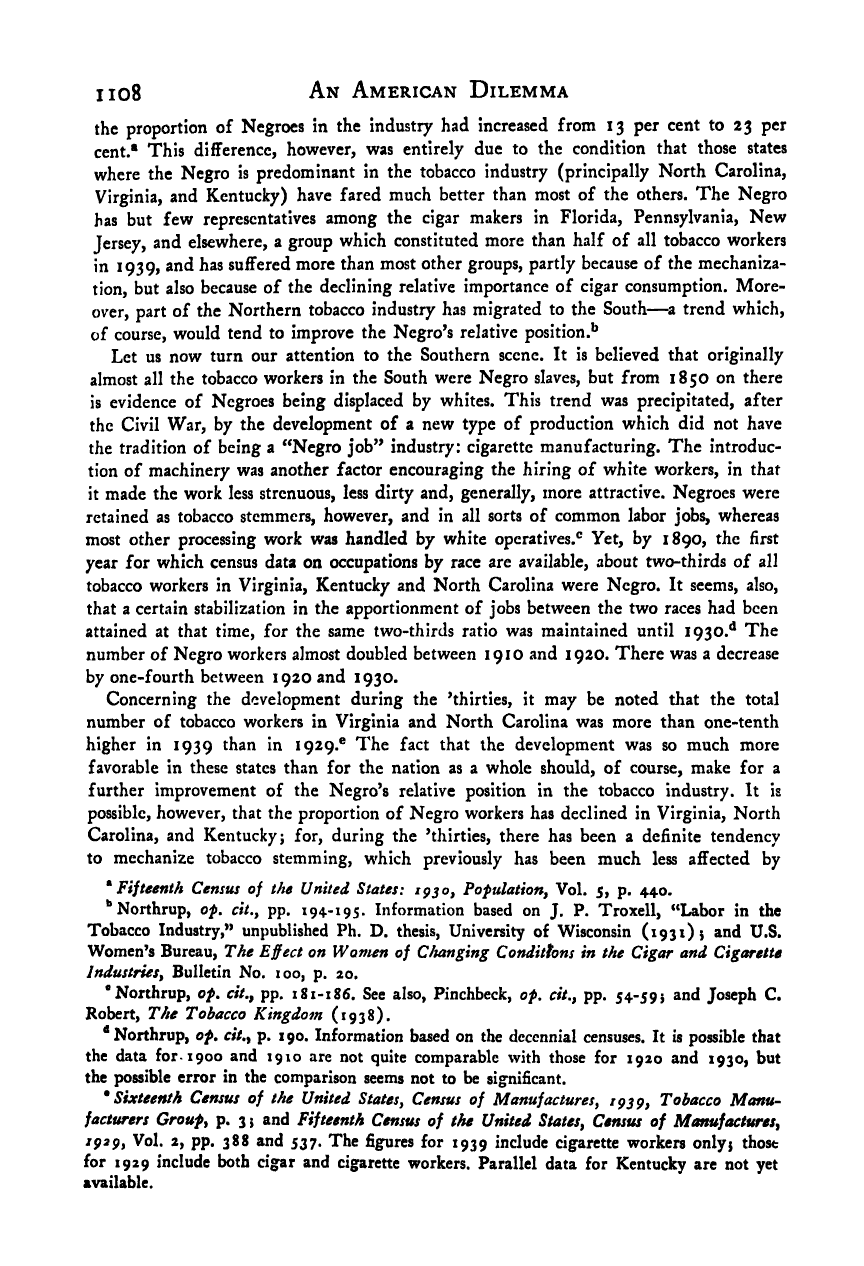Note: Gunnar Myrdal died in 1987, less than 70 years ago. Therefore, this work is protected by copyright, restricting your legal rights to reproduce it. However, you are welcome to view it on screen, as you do now. Read more about copyright.
Full resolution (TIFF) - On this page / på denna sida - Appendices - 6. Pre-War Conditions of the Negro Wage Earner in Selected Industries and Occupations - 10. Tobacco Workers

<< prev. page << föreg. sida << >> nästa sida >> next page >>
Below is the raw OCR text
from the above scanned image.
Do you see an error? Proofread the page now!
Här nedan syns maskintolkade texten från faksimilbilden ovan.
Ser du något fel? Korrekturläs sidan nu!
This page has never been proofread. / Denna sida har aldrig korrekturlästs.
iio8 An American Dilemma
the proportion of Negroes in the industry had increased from 13 per cent to 23 per
cent.® This difference, however, was entirely due to the condition that those states
where the Negro is predominant in the tobacco industry (principally North Carolina,
Virginia, and Kentucky) have fared much better than most of the others. The Negro
has but few representatives among the cigar makers in Florida, Pennsylvania, New
Jersey, and elsewhere, a group which constituted more than half of all tobacco workers
in 1939, and has suffered more than most other groups, partly because of the mechaniza-
tion, but also because of the declining relative importance of cigar consumption. More-
over, part of the Northern tobacco industry has migrated to the South—
a
trend which,
of course, would tend to improve the Negro’s relative position
Let us now turn our attention to the Southern scene. It is believed that originally
almost all the tobacco workers in the South were Negro slaves, but from 1850 on there
is evidence of Negroes being displaced by whites. This trend was precipitated, after
the Civil War, by the development of a new type of production which did not have
the tradition of being a ‘‘Negro job” industry: cigarette manufacturing. The introduc-
tion of machinery was another factor encouraging the hiring of white workers, in that
it made the work less strenuous, less dirty and, generally, more attractive. Negroes were
retained as tobacco stemmers, however, and in all sorts of common labor jobs, whereas
most other processing work was handled by white operatives.® Yet, by 1890, the first
year for which census data on occupations by race are available, about two-thirds of all
tobacco workers in Virginia, Kentucky and North Carolina were Negro. It seems, also,
that a certain stabilization in the apportionment of jobs between the two races had been
attained at that time, for the same two-thirds ratio was maintained until 1930.*^ The
number of Negro workers almost doubled between 1910 and 1920. There was a decrease
by one-fourth between 1920 and 1930.
Concerning the development during the ’thirties, it may be noted that the total
number of tobacco workers in Virginia and North Carolina was more than one-tenth
higher in 1939 than in 1929.® The fact that the development was so much more
favorable in these states than for the nation as a whole should, of course, make for a
further improvement of the Negro’s relative position in the tobacco industry. It is
possible, however, that the proportion of Negro workers has declined in Virginia, North
Carolina, and Kentucky; for, during the ’thirties, there has been a definite tendency
to mechanize tobacco stemming, which previously has been much less affected by
^ Fiiteenth Census of the United States: 1930, Population, Vol. 5, p. 440.
**Northrup, of, cit,, pp. 194-195. Information based on J. P. Troxell, “Labor in the
Tobacco Industry,” unpublished Ph. D. thesis, University of Wisconsin (1931)5 and U.S.
Women’s Bureau, The Effect on Women of Cflanging Conditions in the Cigar and Cigarette
Industries, Bulletin No. 100, p. 20.
*Northrup, of, cit,, pp. 181-186. See also, Pinchbeck, of, cit,, pp. 54-595 and Joseph C.
Robert, The Tobacco Kingdom (1938).
^ Northrup, of, cit,, p. 1 90. Information based on the decennial censuses. It is possible that
the data for- 1900 and 1910 are not quite comparable with those for 1920 and 1930, but
the possible error in the comparison seems not to be significant.
^Sixteenth Census of the United States, Census of Manufactures, 1939, Tobacco Manu-
facturers Grouf, p. 35 and Fifteenth Census of the United States, Census of Manufactures,
1929, Vol. 2, pp. 388 and 537. The figures for 1939 include cigarette workers only; those
for 1929 include both cigar and cigarette workers. Parallel data for Kentucky are not yet
available.
<< prev. page << föreg. sida << >> nästa sida >> next page >>